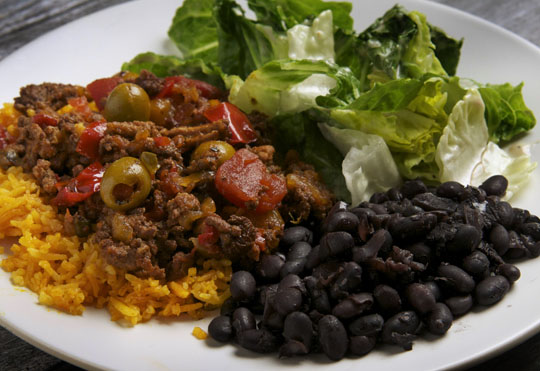
A quick shot of last night's half-time dinner: picadillo on yellow rice with black beans.
Photo by Donna Turner Ruhlman.
I followed a recipe for the first time in ages to make something I'd never cooked before. Whilst down in Key West, I decided to cook a local or near-local preparation. I once said to my friend Nathan Sheffield, Esq., "There's no such thing as good Cuban food." He was justifiably riled and sent me the below recipe for picadillo, a Latin American stew of chopped meat. Nathan is of Cuban heritage and thus his picadillo has lots of cumin and umami-giving olives and capers.
Nathan insists that it be eaten with yellow rice, rice flavored with annatto oil. Annatto seeds are simmered in oil to make a red-orange oil that has a flavor like no other—difficult to describe but in the cinnamon range with bitterness rather than sweetness. It's the defining seasoning here.
To make a simple yellow rice, sauté onions in annatto oil:
Then add rice and water or stock and cook. The same method can be used for black beans, though I used bacon and onions yesterday. I make a big batch of annato oil by sight, combining plenty of seeds with about three times the amount of oil. Or you can follow the recipe here, but double it for the yellow rice. It will keep for a few weeks refrigerated. Nathan uses potatoes; this is starch overkill and I recommend you don't. Nathan says you must put a layer of your favorite hot sauce between the rice and the stew, a conviction with which I concur enthusiastically. "There's something about the alchemy of the hot sauce being under the stew that makes it bloom in a magical way," Nathan says.
Nathan cooks the meat first, then adds the vegetables. I cook the vegetables to develop their flavor and sear the meat in a separate smoking hot pan for good browning, then add the meat and as much of the fat as I feel like to the vegetables, followed by the seasonings, followed by the liquids and tomato.
The following batch (with rice and beans) fed six people with leftovers. This is a great meal to make for a Sunday dinner and to have leftovers later in the week. Serve it as a taco filling with cheese on top if you wish or on more rice. It's fabulous.
Nathan Sheffield's Picadillo
- 1 tablespoon annatto seeds
- 3 tablespoons olive oil
- 1 pound lean ground beef
- 1 pound ground pork (not traditional but it tastes pretty damn good)
- 4 to 5 garlic cloves, roughly chopped
- 2 medium Spanish onions, diced
- 1 large red bell pepper, diced
- 1 large yellow bell pepper, diced
- Salt and pepper to taste (pretty damn aggressively)
- 1 tablespoon ground cumin
- 1 teaspoon adobo con pimiento (chipotles)
- Red pepper flakes to taste
- 1 ½ teaspoons dried Mexican oregano (or generic)
- ½ cup raisins
- ¾ cup stuffed manzanillo olives
- 1 to 2 tablespoons capers (with the brine)
- 2 cups drinkable red wine
- 1 (28-ounce) can plum tomatoes, finely diced
- ¼ cup rice wine vinegar (trust me on this)
- 3 large Yukon Gold potatoes, peeled and cut into ½-inch cubes
- Your favorite hot sauce (Crystal's is the most traditional), for serving
- In a small sauté pan, place the annatto seeds and the olive oil over medium low heat (I always make extra of this stuff just to keep in the fridge) until the seeds have become dark amber in color and the oil has become fragrant and saffron-colored. Strain the oil into a heavy-bottomed dutch oven (I pull out my trusty Le Creuset).
- Over medium heat, brown the beef and pork completely before adding the garlic, onions, and peppers. Season with salt and pepper. Reduce the heat and sweat the vegetables together with the meat for approximately 10 minutes.
- Season well with the cumin, adobo, red pepper flakes, and oregano and add the raisins, olives, and capers. Cook for another 10 minutes, stirring frequently—the fond should be pretty thick on the bottom of the pot. Deglaze with red wine and simmer for 20 minutes.
- Add the tomatoes (with their juices) and vinegar, reduce to low heat, and simmer (partially covered) for 2 to 3 hours—or, if you're as lazy as I am, you can just throw it in the oven at 300°F for a few hours. In the last hour, add the potatoes. Taste and add more salt and pepper if needed. Don't forget to put a layer of hot sauce between the rice and stew, per Nathan's instructions.
Other links you may like:
- Norman Van Aken has a new book on Key West cooking, My Key West Kitchen.
- It was photographed by the wonderful Penny De Los Santos, who has a wonderful site.
© 2013 Michael Ruhlman. Photo © 2013 Donna Turner Ruhlman. All rights reserved.



Potatoes and rice may be "starch overkill", but the combination is surprisingly good. Biryani often contains potatoes and has some spices similar to the dish you describe.
The Picadillo sounds delicious.
Great recipe. This stuff can be used as a filling for many great dishes.
This looks delicious... not sure about the pork, but... why not? I have been looking for a good recipe for picadillo to try, and I think this will be the one. Its one of my favorites in Cuban restaurants, and makes an excellent empanada filling, too!
The old timers would fry the potatoes before adding at the end.
Adobo con pimiento? (chipotle= Mexican...!) not sure what that is. Adobo (wet or dry) is literally marinade, although Puerto Rican, Carmen Aboy de Valldejuli describes it easily in her books. (Puerto Ricans also lay claim to Picadillo) But never with adobo (and Please tell me you steered clear of Goya powders with their MSGs, dyes and chemicals)
Maybe you mean Sofrito (as Puerto Ricans say) or Sasón (say Los Cubanos) a purée of Cilantro, Culantro (wide leaf), aji cachucha (or aji dulce/sweet peppers that look like small Scotch Bonnets) onions, and garlic. I like your description and respect for achiote oil from the annato seed (these from the Lipstick Tree which gives lipstick it's color)
And Yes x Yes with the previous comment here; make lots extra and place in round pastry shells folded over and sealed with fork tines and freeze and you'll always have a batch of Pastelillos on hand. Goya makes a fine frozen pastry shell. Just thaw, fill, fold and seal.
Now as to your insouciant remark about no good Cuban Food, well that's just silly. A good primer is A Taste of Old Cuba by María Josefa Lluriâ de O'Higgins. So get on it there's a world of wonderful food to love from Cuba and with your genius you can show us new ways of approaching it. Once you master Lechón, you'll eat more thanjust your words. ¡Buen Provecho!
According to Eugene Walter's "Hints & Pinches," the first European explorers in the Americas saw whole families dyed red with annatto as a sunscreen and assumed that they were red, and called them "redskins." He asserts that because they weren't immune to the sun like most tropical peoples, they probably migrated from Asia.
I said something similar to my husband, who is Cuban, but it was more along the lines of how could you remain healthy eating the typical Cuban diet all the time? While it's true that what has come to represent the cuisine, especially in restaurants, is heavy on meat, deep-fried foods, and heavily sugared desserts and coffee, my husband, whose family left Cuba shortly after Castro's regime came into power (see Andy Garcia's movie Lost City for an accurate representation of that time), remembers his paternal grandfather eating a pre-meal soup and some type of seafood or fish every night, and also maintaining a small backyard farm with chickens and vegetables while on the island.
I made picadillo once on a whim because I happened to have all the ingredients on hand. We loved it. Now I'm looking forward to trying this recipe.
I am glad you decided to open yourself to a new experience regarding Cuban food. As Michele mentioned above, it has a lot more to offer aside from the typical fried and sugary counter food found in Miami. Cuban food actually has deep roots in West African, French, Spanish, Chinese, and Native Indian tribes (Tainos, Ciboneyes, and the Guanahatabeyes). In the 1800's, the affluent crowd was actually eating lots of offal, in the style of Escoffier.
Post WWII, Cuban households kept up with the canned foods phenomenon happening in the USA. Post Castro revolution, what happened on the island was a shift towards rationed food, leading to a scarcity of animal proteins, lack of imported gourmet foods (better understood as they could no longer keep up with the dining trends in the USA), and less variety in vegetables, as farms were basically overrun by the government. In Miami, what the exiles transported was exactly where they had left off before the Castro revolution--the pre-packaged canned foods of the 1950's and 1960's. Hence, you have spice mix packets, canned guava shells, canned beans, and bottled marinades. The generation of Cuban-Americans born in Miami have little idea of what a real guava or sour orange even looks like, or take the time to appreciate that the bechamel sauce in their Cuban diner croquettes is French gastronomy 101.
My cuban in-laws always serve with a lightly fried egg on top of the (white) rice. Makes for amazing late night snack after bar hopping.
I really enjoyed the history and background on the recipe and Cuban food in general from the other people who posted. The suggestion to use it as a filling and also the fried egg on top sound great!
So I take it you don't like El Mason de Pepe? I LOVE Key West and was recently there myself (wish I still was as we are about to get 2 ft of snow in RI!). Ana's Cuban Cafe is very good. I love picadillo and will try your recipe. I have made it before and it is also really good with yucca- mashed w/ garlic.
I was basically browsing for creative concepts for my personal blog and
uncovered ur article, “Picadillo | Michael Ruhlman”, will you care
if I personally work with a bit of of ur tips? Thanks a lot ,Carlota
I have been making Picadillo for over 20 years, I would never put hot sauce....and you make this recipe way too complicated. It’s like the simplicity of this was forced into something ridiculous lacking authenticity.
Well, let us know you you make yours please!
Here is my great grandmother’s recipe for black beans, yellow rice, and Picadillo. She was 100% Cuban, by the way.
Black beans , yellow rice, and picadillo
One pound black beans soak in olive oil about 1 cup and a whole bell pepper over night don't rinse! Add water if needed and cook the next day.
Cook yellow rice as directed
Picadillo
3 pounds hamburger
1 large bell pepper
2 large onion
1 can diced tomatoes
1 can tomato paste
1 large ragu
Olive oil
Cook hamburger til done pour off grease from hamburger
Chop onion and bell pepper saute in olive oil add hamburger and diced tomatoes and paste and ragu simmer at least 2 hours longer if you have the time . the longer it simmers the better it is.